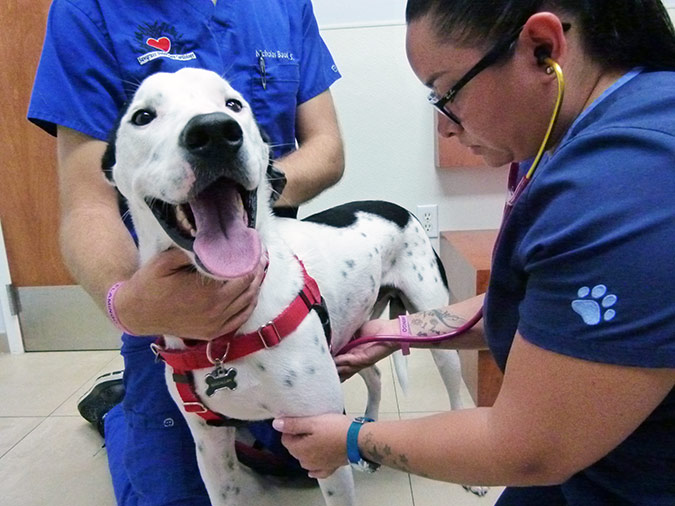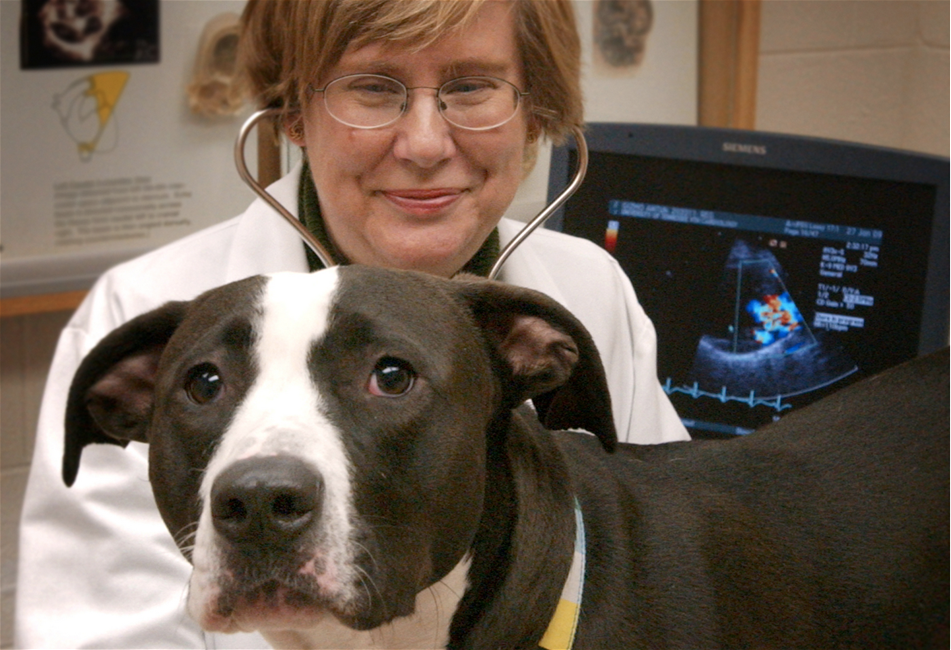What You Need to Know Concerning Vet Services: A Summary of Diagnostic Devices and Procedures
Veterinary services play a vital duty in maintaining the health of animals. Regular exams can expose concealed health worries at an early stage. Numerous analysis devices and procedures, such as blood examinations and imaging methods, offer vital understandings into a pet's wellness. Recognizing these techniques is vital for pet owners. What specific diagnostic treatments are most typically used, and just how can they influence a family pet's therapy plan?
Significance of Regular Veterinary Check-Ups
While many family pet owners may ignore the significance of regular veterinary check-ups, these visits are essential for maintaining a pet's overall health and wellness. Regular sees to the vet enable early discovery of potential wellness issues prior to they intensify into major issues. Normal check-ups frequently consist of vaccinations, which are necessary for avoiding transmittable diseases that can severely influence a pet's health. Furthermore, these appointments offer a possibility for veterinarians to evaluate the animal's weight, oral wellness, and total problem, ensuring that the animal is thriving. During these sees, family pet proprietors can additionally obtain beneficial guidance on diet regimen, workout, and precautionary care tailored to their details pet dog's demands.
Typical Analysis Procedures in Vet Medication
In vet medication, exact medical diagnosis is crucial for reliable therapy. Usual analysis treatments include blood testing methods, advanced imaging modern technologies, and urinalysis, each playing a substantial role in identifying wellness problems. Comprehending these methods boosts the ability to supply ideal take care of animal individuals.
Blood Evaluating Strategies
Blood testing strategies work as necessary analysis devices in veterinary medicine, enabling veterinarians to assess the health and wellness of pets accurately. These techniques involve gathering blood examples to evaluate different components, such as white and red blood cells, platelets, and biochemical pens. Typical examinations include complete blood matters (CBC), which evaluate general health and wellness and spot infections, and biochemical panels, which assess organ feature and metabolic condition. In addition, serological tests can identify specific diseases through antibody discovery. Blood testing is minimally invasive and offers important information that aids in diagnosing problems, monitoring health and wellness status, and examining reactions to therapies. In general, these techniques play a crucial duty in ensuring optimal look after animals and livestock alike.
Imaging Technologies Used
Diagnostic imaging modern technologies are necessary tools in veterinary medicine, complementing blood screening techniques by giving aesthetic insights right into a pet's inner structures. Common imaging methods include X-rays, which are useful for assessing bone cracks and finding foreign objects, and ultrasound, which permits for real-time visualization of soft tissues and body organs. Magnetic vibration imaging (MRI) offers comprehensive pictures of complicated anatomical locations, specifically in neurological assessments. Computed tomography (CT) gives cross-sectional pictures, boosting diagnostic precision for numerous problems. Each of these innovations aids vets in detecting health problems, planning therapies, and keeping track of recovery. By integrating imaging innovations, vet experts can much better assess a pet's health and wellness and make informed choices regarding their care.
Urinalysis and Diagnostics
Urinalysis serves as a crucial diagnostic device in vet medicine, giving useful understandings into a pet's overall health and aiding in the discovery of numerous problems. This non-invasive treatment examines urine samples to analyze kidney function, hydration condition, and metabolic problems. Usual components checked out include specific gravity, pH levels, glucose, proteins, and the existence of blood or germs. Abnormal findings can suggest problems such as urinary system infections, diabetic issues mellitus, or kidney disease. To enhance analysis accuracy, urinalysis is typically done along with other examinations, such as blood job and imaging research studies. Early discovery with urinalysis can cause prompt treatments, boosting the prognosis for many vet clients. It is a vital aspect of detailed veterinary treatment.
Comprehending Blood Tests and Laboratory Analysis
Understanding blood tests and research laboratory analysis is vital in veterinary medicine as it aids in detecting numerous health conditions in animals. Various kinds of blood examinations offer crucial information regarding an animal's inner state, while analyzing lab results needs careful factor to consider of countless factors. This section will explore the sorts of blood examinations readily available and the significance of their results.
Sorts Of Blood Tests
Blood tests play a crucial role in veterinary medicine, offering crucial insights right into an animal's health and wellness status. Numerous types of blood tests are made use of, each offering different objectives. Full blood counts (CBC) analyze total wellness and spot problems such as anemia or infection. Biochemical accounts assess organ feature by determining enzymes and electrolytes, offering understandings right into metabolic health and wellness. Serological tests identify particular antibodies or microorganisms, aiding in the diagnosis of infections or autoimmune illness. Blood typing guarantees safe transfusions, while coagulation tests determine the blood's capacity to embolisms, important for procedures. These examinations jointly improve diagnosis, therapy preparation, and monitoring of an animal's health, showing the value of complete laboratory analysis in veterinary treatment.

Translating Laboratory Outcomes
A comprehensive analysis of lab outcomes is important for accurate diagnosis and therapy in vet medication. Translating lab results requires an understanding of normal recommendation ranges and the significance of variances. Blood examinations can disclose different health and wellness signs, such as body organ feature, electrolyte balance, and the visibility of infections. Vets have to take into consideration the whole medical image, including the pet's background, physical evaluation findings, and any signs and symptoms presented. Variations in results might develop from variables such as age, type, and underlying wellness problems. Consequently, lab results should not be viewed in seclusion but instead as component of a comprehensive diagnostic approach. Exact interpretation permits customized therapy plans and better outcomes for vet clients.
Imaging Techniques: X-rays, Ultrasounds, and Beyond
Imaging techniques are essential tools in vet medication, giving important understandings right into the health and wellness and wellness of pets. Amongst the most commonly used approaches are X-rays and ultrasounds. X-rays are important for visualizing bone frameworks, aiding vets identify fractures, lumps, or international items. This approach is non-invasive and quick, making it excellent for immediate situations.Ultrasounds, on the other hand, use acoustic waves to create photos of soft cells and body organs. This method is particularly beneficial for examining the heart, abdomen, and reproductive body organs, permitting vets to analyze problems like fluid accumulation or body organ abnormalities.Beyond X-rays and ultrasounds, progressed imaging methods such as computed tomography (CT) and magnetic resonance imaging (MRI) are progressively utilized in veterinary practice. These approaches provide comprehensive cross-sectional images, enhancing the accuracy of diagnoses and treatment strategies. Board Certified Veterinary Cardiologist. On the whole, imaging strategies play a vital function in making certain efficient vet treatment
The Role of Biopsies in Diagnosing Animal Health Issues
Accuracy in detecting wellness issues in pets frequently pivots on the usage of biopsies, which supply conclusive info concerning cells abnormalities. A biopsy includes the removal of a small sample of tissue for assessment under a microscope, allowing veterinarians to determine numerous conditions, including infections, tumors, and inflammatory conditions. This diagnostic device is crucial for comparing malignant and benign growths, directing treatment decisions, and examining the seriousness of a condition.Biopsies can be performed using numerous strategies, such as needle aspiration, incisional biopsies, or excisional biopsies, depending upon the place and kind of tissue involved. The option of technique may influence recuperation time and the amount of tissue collected. Ultimately, the info obtained from a biopsy can result in targeted treatments, enhancing results for family pets dealing with severe wellness difficulties. Vets stress the significance of this treatment in attaining precise medical diagnoses and efficient treatment strategies.
Advanced Diagnostic Tools: Endoscopy and CT Scans

Advanced diagnostic tools, such as endoscopy and CT scans, play a crucial duty in modern-day veterinary medicine, supplying non-invasive methods to picture internal structures and identify different problems in pet dogs. Endoscopy involves the use of a flexible tube furnished with a cam, allowing veterinarians to take a look at the intestinal tract and breathing system straight. This method can disclose irregularities such as lumps, international bodies, or inflammation, enabling targeted therapy plans.CT scans, on the other hand, make use of sophisticated imaging modern technology to produce detailed cross-sectional photos of the body (Ultrasound For Dogs). This technique is specifically visit this site right here useful for evaluating complicated structures like the brain, spine, and joints. By providing high-resolution images, CT scans help veterinarians in identifying problems that might not be noticeable with traditional radiography. Together, these advanced tools enhance analysis accuracy, enhance therapy end results, and inevitably add to far better general family pet wellness administration

Interpreting Examination Outcomes: What Pet Owners Must Know
Comprehending examination outcomes can be a challenging task for pet proprietors, specifically after advanced procedures like endoscopy and CT scans have actually been carried out. Analyzing these results needs an understanding of clinical terminology and a clear understanding link of what the searchings for indicate regarding the pet dog's wellness. Vets usually provide explanations, however the intricacy of the results can still cause confusion.Pet owners ought to actively participate in conversations with their vets, asking questions to clarify any uncertainties. It is necessary to comprehend typical versus abnormal results and the effects for the pet dog's therapy strategy. Additionally, recognizing that some results may require more screening or monitoring can help proprietors stay educated regarding their family pet's wellness trip. Inevitably, a collaborative technique in between family pet proprietors and vet professionals fosters much better health and wellness end results and enhances the general care experience for pet dogs.
Regularly Asked Questions
Just how Do I Pick the Right Vet Center for My Animal?
Selecting the appropriate veterinary facility includes researching regional choices, reviewing qualifications, visiting centers, and analyzing staff communications (CT Scans For Dogs). Focusing on recommendations from trusted resources can aid guarantee the very best treatment and setting for an animal's wellness demands
What Should I Do if My Family Pet Refuses to head to the Veterinarian?
When a family pet refuses to go to the veterinarian, it's suggested to continue to be tranquil, usage deals with or playthings to entice them, and think about setting up a home check out if stress and anxiety lingers. Patience and favorable reinforcement are crucial.
Exist Telehealth Options for Veterinary Solutions?
Telehealth choices for vet solutions are significantly available, allowing pet dog owners to seek advice from with veterinarians remotely. These services enable conversations about wellness problems, recommendations on minor disorders, and follow-ups without requiring to check out a facility.
Exactly how Frequently Should My Family Pet Have Dental Check-Ups?
The frequency of dental check-ups for family pets usually relies on their age and type. Normally, vets advise annual dental analyses, although some pets may call for more constant brows through to maintain ideal oral wellness.

What Are the Prices Related To Vet Diagnostics?
The costs connected with veterinary diagnostics can vary widely, generally varying from fundamental examinations like blood work to sophisticated imaging important site strategies. Variables influencing expenditures consist of the center's place, equipment utilized, and certain tests required for every pet. Vet solutions play a vital function in maintaining the health and wellness of animals. While many pet proprietors might undervalue the importance of normal veterinary check-ups, these appointments are necessary for keeping a pet's overall health. In addition, these consultations supply a chance for vets to examine the pet's weight, dental wellness, and overall condition, ensuring that the animal is flourishing. Accuracy in detecting health issues in pets usually pivots on the usage of biopsies, which offer definitive information regarding tissue abnormalities. Additionally, identifying that some results may require more screening or tracking can assist proprietors remain notified regarding their pet's wellness journey.